The 2020/21 season marked a 19-year wait for Sporting Lisbon to be crowned Primeira Liga champions.
A return to the top of the Portuguese pyramid coincided with the arrival of former Benfica midfielder Rúben Amorim in the managerial dugout, who was recently linked with the vacancy at Premier League outfit Liverpool.
Although it’s not always been plain sailing since Amorim’s arrival, Sporting have established a tactical identity and secured another domestic league title last campaign.
Leões have continued to dominate this season.
Eight fixtures in, they currently sit top of the league on maximum points.
It is not only domestically, though, where teams have struggled to get the better of Amorim’s side.
At the time of writing, Sporting are unbeaten in this season’s Champions League with one victory and one draw.
With an unbeaten start, having played roughly a quarter of the season, is there any stopping this Sporting side?
This tactical analysis will provide an overview of Ruben Amorim’s team and determine how opponents could challenge the current Portuguese leaders in open-play scenarios.
We will
analyse the tactics deployed at the Éstadio José Alvalade and provide solutions to combat such tactics, showcasing how Sporting’s dominance couldend.
Ruben Amorim’s Coaching Style
Ruben Amorim has imposed an offensive and controlling style of play since his arrival in Lisbon.
Sporting tend to line up in a 3-4-3 formation, which facilitates controlling different areas of the pitch.
The wider of the back three will disperse to allow the wider options in the four-man midfield to push up into the final third.
This ensures that in the attacking third, Sporting are able to commit at least five men, often creating a numerical advantage against their opponents.
Moreover, the wider of the front three inverts towards the half-spaces to ensure that when Sporting occupies space in the final third, they are using the absolute width of the pitch.
The wider of the front three are also important figures in Sporting’s attacking transitions as they often look to provide passing options for the deeper-lying double pivot in midfield, as demonstrated in the image below.
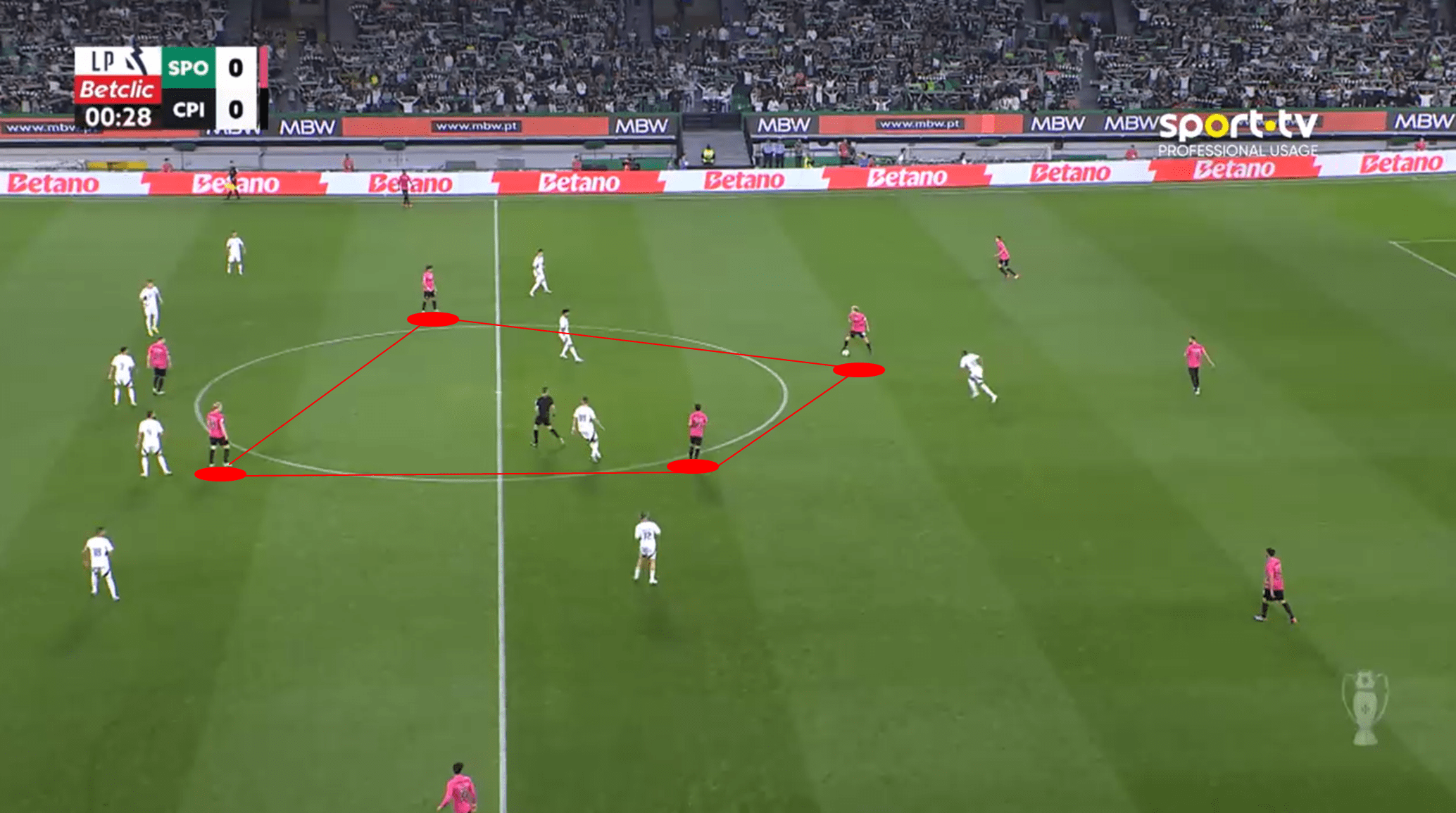
As the above shows, the Lisbon outfit utilises a box midfield, which is effective in congesting the central areas of the pitch.
Such congestion allows Sporting greater dominance in possession as the passing options cover shorter distances and will enable them to retain the ball with quick passing exchanges.
With such control in matches, Sporting has asserted itself as a dominant force in Portugal’s top flight.
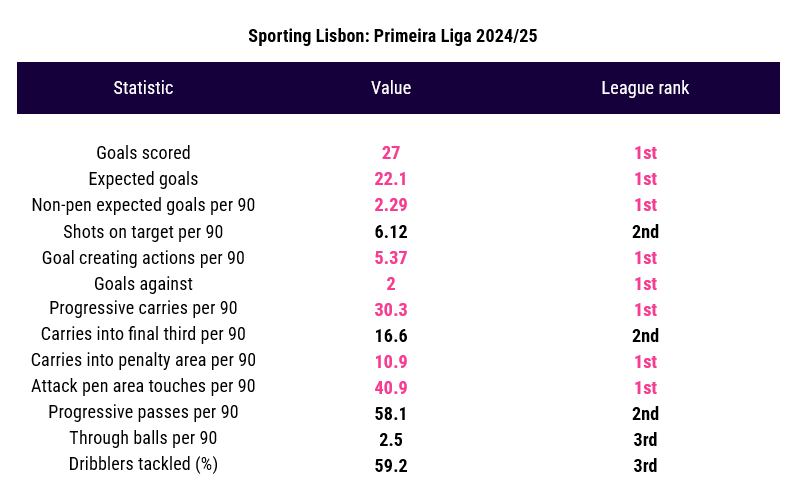
The table shows just how dominant in the league this season Sporting has been for numerous metrics, particularly from an attacking perspective.
Considering Sporting tops the possession charts, averaging 65.4% possession per match, the fact the Lisbon-based side is third for the percentage of dribblers tackled won this campaign also highlights their defensive strengths.
Amorim deploys a high defensive line to congest the pitch further and focuses on counter-pressing strategies to maintain control in matches.
Therefore, the Sporting way at present points to an aggressive side in and out of possession.
How to Disrupt Sporting’s Rhythm
Opposing teams need strong organisation and flexibility in positioning, particularly without the ball, to take on this sporting side.
If the sides set up with four at the back, they are likely going to be outnumbered in their defensive third due to the numerical overloads Leões deploy in the attack.
Therefore, teams would be wise to line up with five in their defensive line, especially when defending in a low block.
This would not only mean they are not numerically at a disadvantage in the final third, but it would also enable sufficient cover to combat the threat of Sporting’s forward line, led by Viktor Gyökeres.
The former Coventry forward is Sporting’s talisman and has scored 27% of the Amorim side’s open-play goals this season.
Gyökeres is a physical presence up front, often showcasing his strength in battles with opposition centre-backs.
Once past defenders, despite his tall stature, he is quick and powerful at accelerating play forward.
The Swede’s technical ability ensures he isn’t specifically a target man as he will often rotate position in the forward line with the wider options Francisco Trincão and Pedro Gonçalves.
Gyökeres tends to favour interchanging on the left side, as exemplified below slightly.
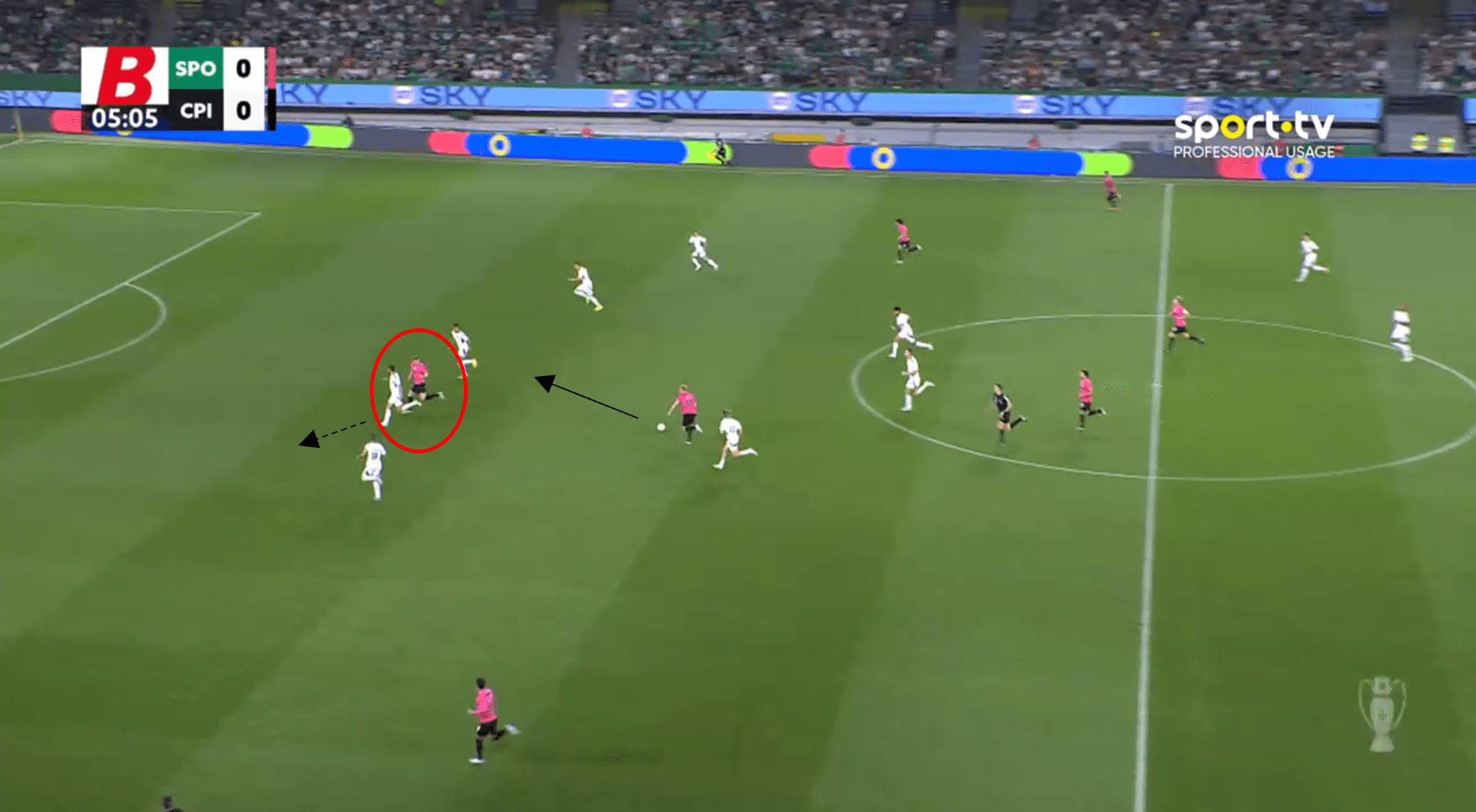
The forward’s off-the-ball movement created space for his teammate to drive forward centrally as the opposing defender opted to track the Swede’s run, which is often the case.
If sides played five at the back with one of the three central defenders marking Gyökeres, the other two central defenders could operate as a second defensive line to cover any potential gaping spaces in the defensive line.
Had Casa Pia not had five at the back in the above example, space would have opened up centrally for Sporting to drive into because of Gyökeres’ movement.
As we previously discussed, sides will need to be tactically flexible against Amorim’s side.
Sporting are an intelligent side when in possession and will look to create passing angles in their box midfield to play through the opposition.
It would require a lot of defensive discipline for teams to sit back and allow Sporting the majority of the play for the full 90 minutes.
A feature of the Lisbon outfits play is to be patient and lure their opponents into a press.
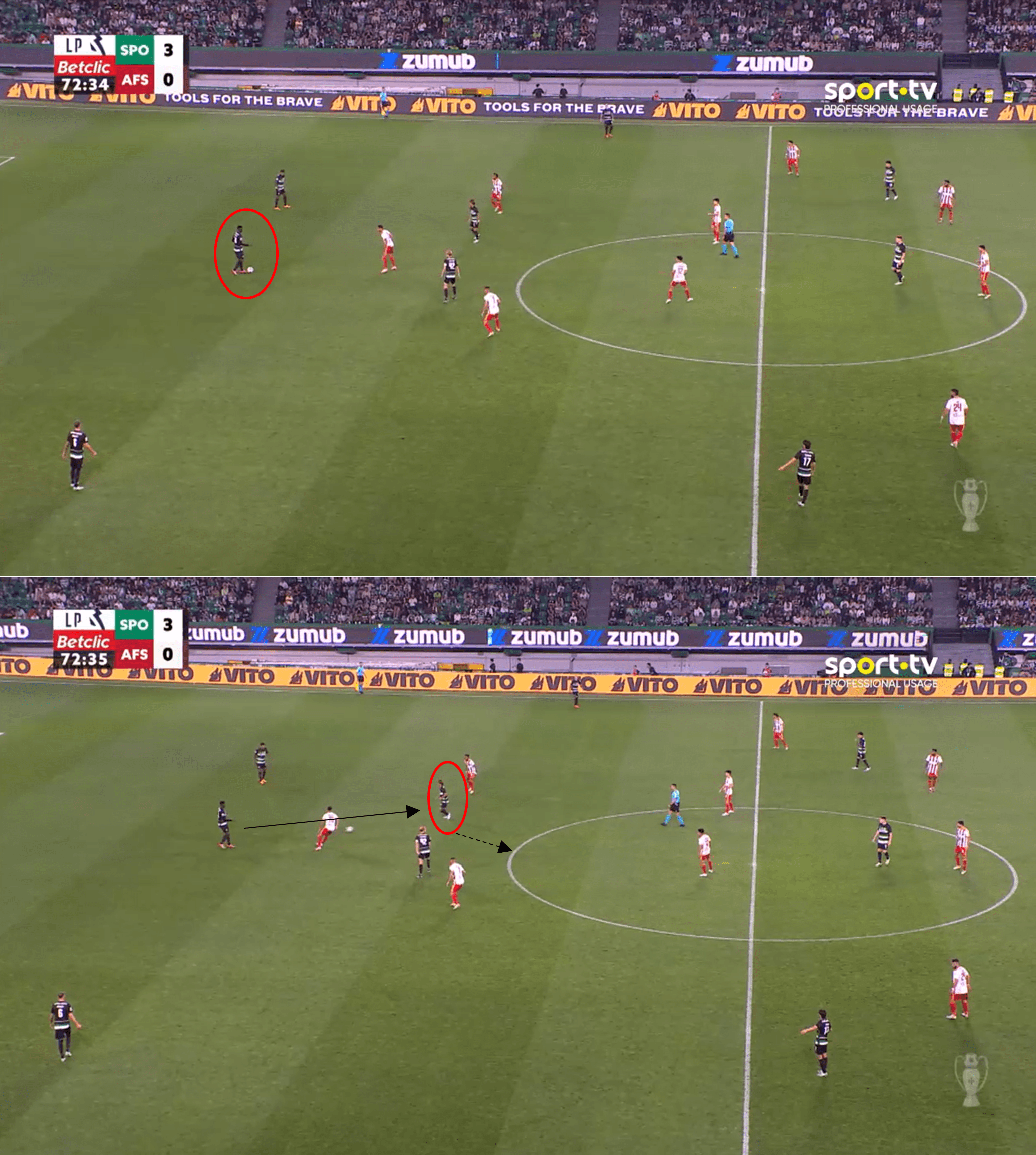
The central defender pauses in possession, and as soon as his opponent moves forward to press, he passes forward to the midfielder, who immediately turns and drives forward into the space that had previously been occupied by the opposing forward.
By inviting the opposition to press, Sporting are able to exploit spaces to their advantage.
Amorim’s side often dictates the narrative of matches, so teams should question this side’s defensive merit.
Notably, the only side to come away with anything against Sporting this season has been PSV in the Champions League.
The Dutch side adopted a much more aggressive approach than what Sporting have been used to facing domestically.
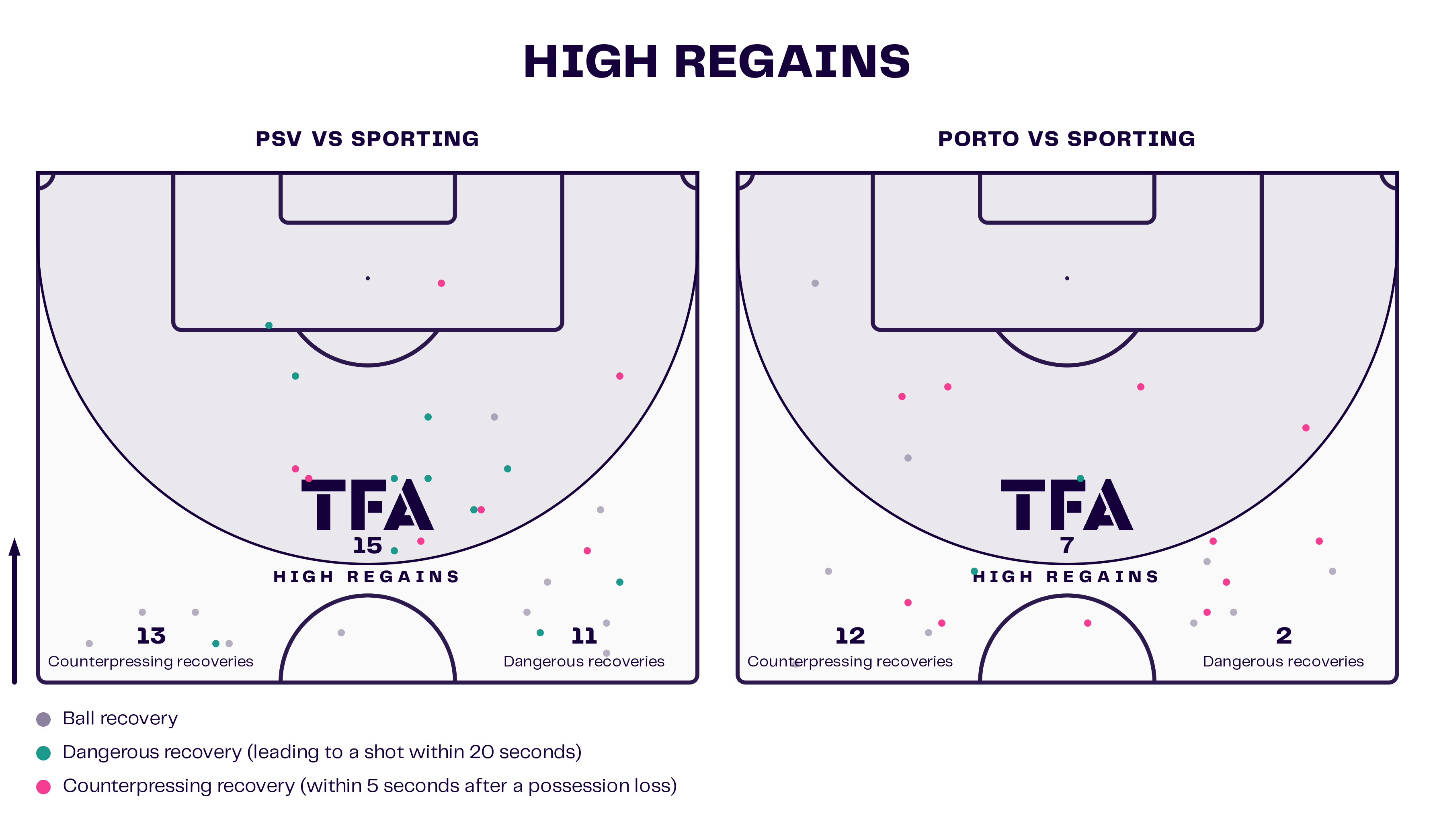
The graphic compares PSV’s pressing strategy against Sporting to that of the Lisbon side’s closest league rivals this season, Porto.
PSV pressed Sporting higher up the pitch than Porto and particularly looked to make more dangerous recoveries on the attacking right-hand side.
It was a strategy that worked to their advantage.
The Dutch team took the lead by applying pressure and not allowing Sporting time in possession.
Teams have often had a tendency to give Sporting a lot of respect. While Leões are a strong side, if teams took the game to Amorim’s side and played on the front foot in the opening stages, it could ensure Sporting are not given the time to settle into a game and control from the offset as they so often do.
However, whilst an aggressive press could be rewarding against Sporting, it is a tactic that will have to be managed as it would be difficult to sustain at a high intensity for the full match.
The opposition needs to be mindful of the Lion’s box midfield.
To effectively prevent Sporting’s attacking transitions, utilising a 4-4-2 mid-block would have advantages.
When out of possession, the 4-4-2 would ensure a man-for-man approach in the centre of midfield and block any passing lanes to wider areas of the pitch.
Any pressing against Sporting in this shape will need to be a coordinated team effort because if a player takes the Sporting bait and doesn’t hold the team shape, gaps could be exposed for Sporting to play into.
Therefore, out-of-possession teams could look to use a hybrid 5-4-1/4-4-2 formation, sacrificing an attacking player and prioritising defending in numbers in the deeper defensive phases.
How To Beat The Sporting High Line
The Sporting backline has only been broken three times in the league and Europe this season.
This is despite Sporting’s playing an exceptionally high defensive line, which, as shown in the graphic below, is near the halfway line on average.
Sporting CP Defneisve Territory Chart
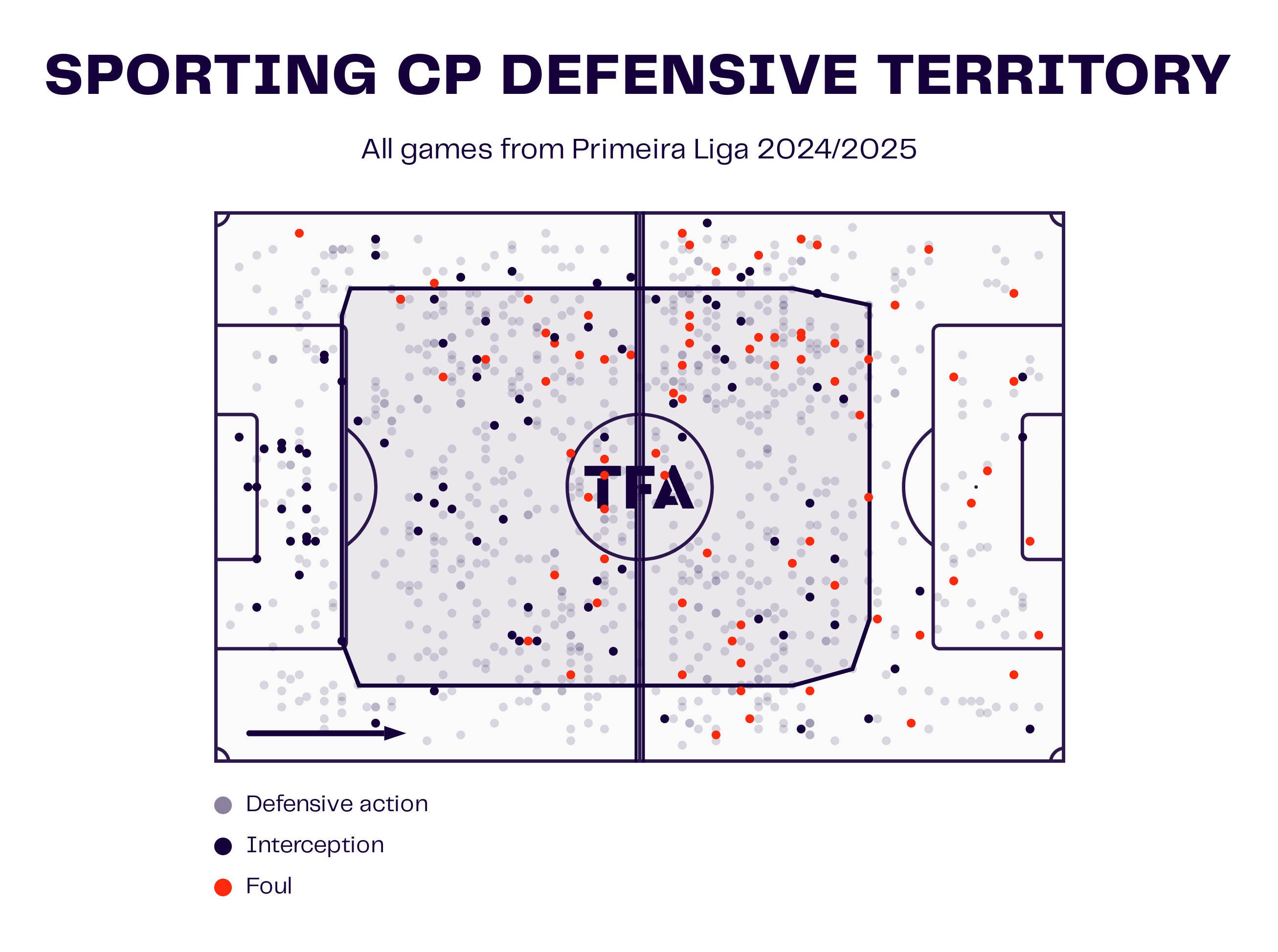
The use of a high defensive line is risky because if teams are able to beat the offside trap and attack at pace, they could find themselves in an advantageous attacking position.
This is precisely the case below, where the forward is playing off the shoulder of the deepest-lying Sporting defender, who he eventually beats for pace and scores.
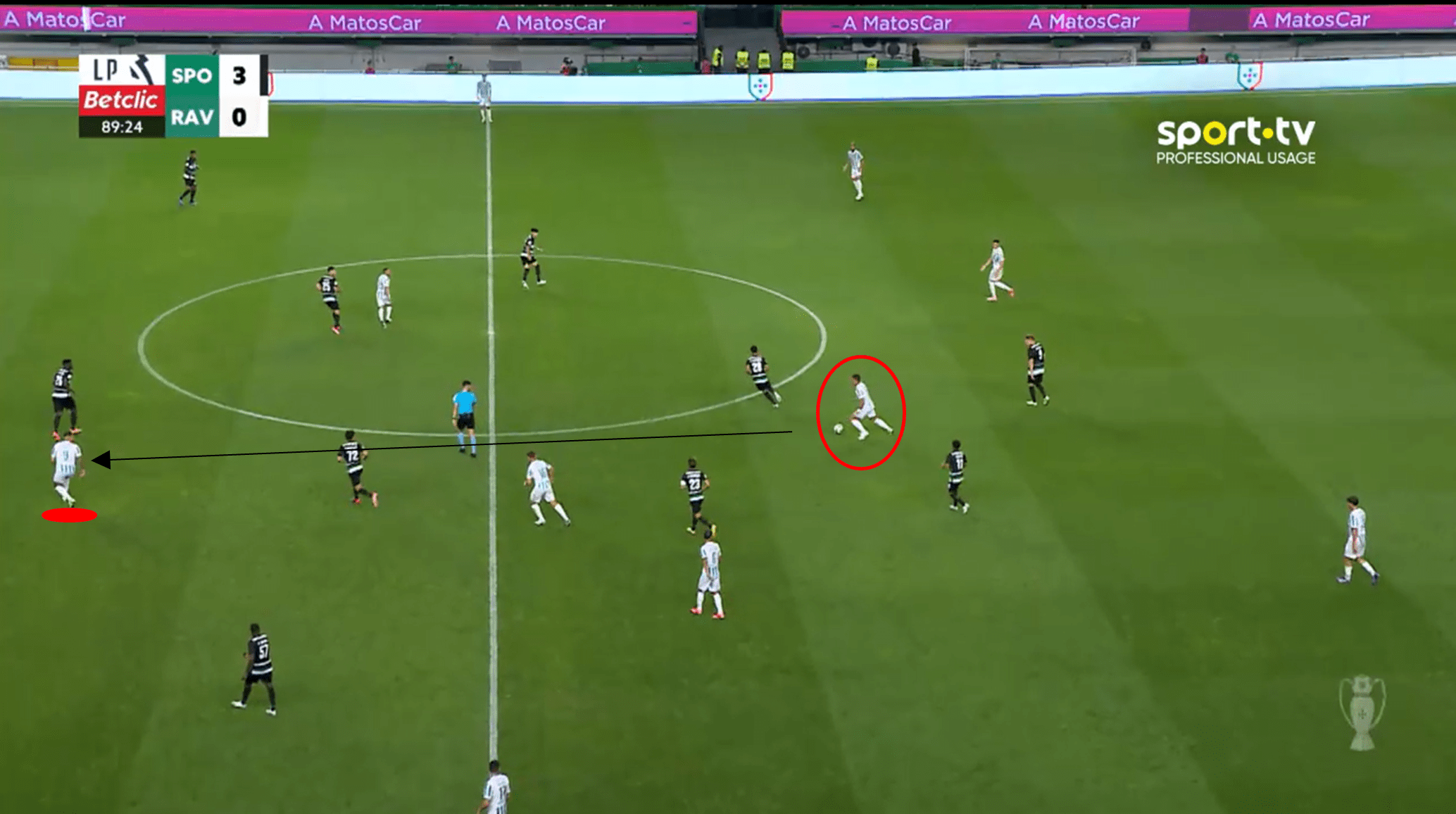
However, teams have rarely threatened with counterattacks against Sporting this season – something they should look to do.
When the opposition retrieves possession in the deeper 5-4-1 formation or the 4-4-2 mid-block, they should look to impose a quick, direct style of play.
This can be achieved by keeping at least one forward high up the pitch in a slightly wider position to exploit Sporting’s play with only three at the back.
While the counterattack would be a solution in transitions, teams also need to be resourceful in their build-up play.
For example, in their recent league fixture against Sporting, Casa Pia would launch their goal kicks, but this often gifted possession back to Sporting, allowing the Lisbon side to continue to dominate proceedings.
Sporting CP Heat Map
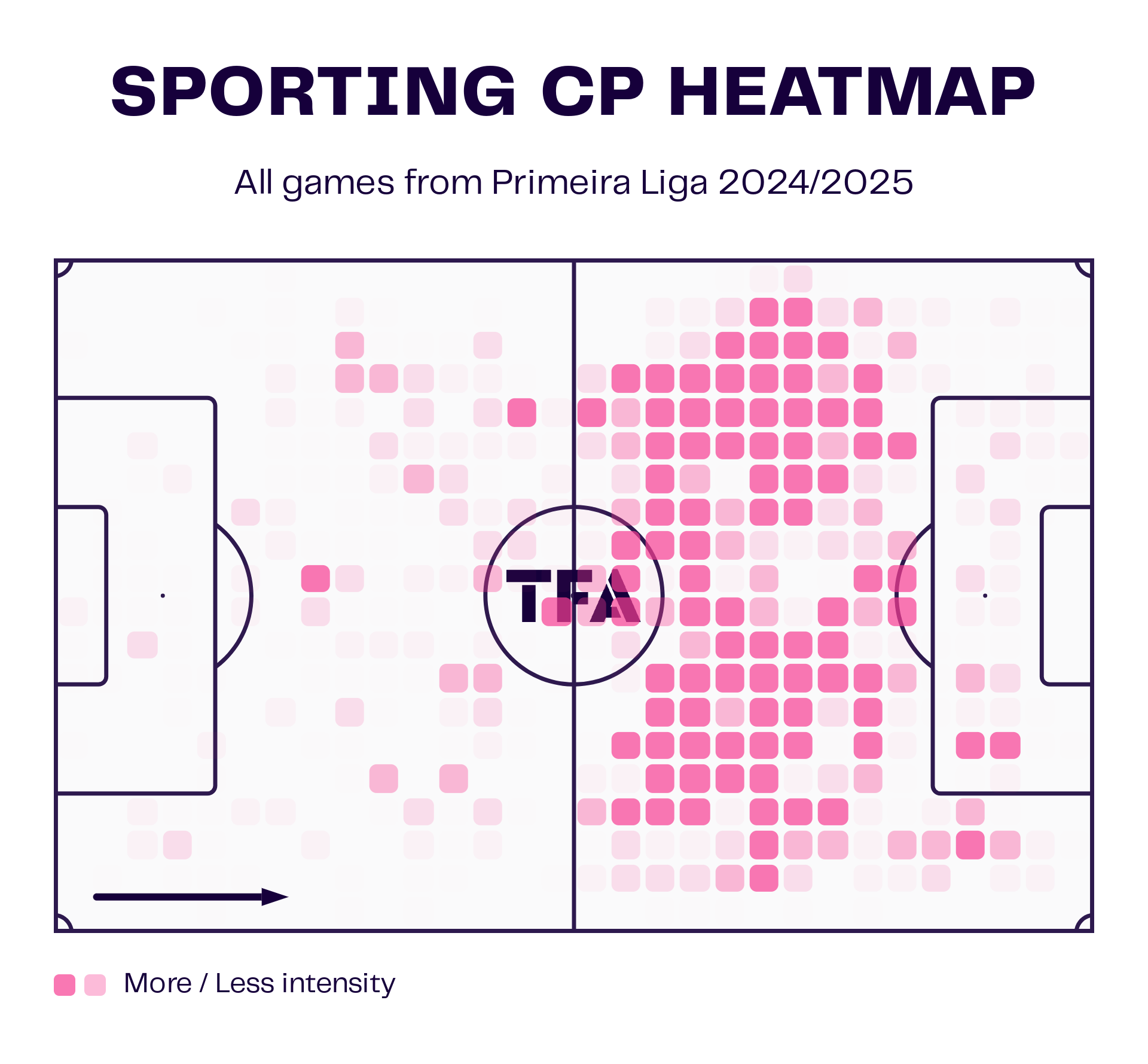
The heatmap above shows that domestically, Sporting has spent the majority of matches in the opposition half, achieved by their high defensive line and tendency to intensely counter-press.
Sporting looks to block the opposition’s defensive midfield passing option, as shown below with the positioning of Gyökeres, and force play out to the wider areas, ensuring the opposition has less space to progress play out from.
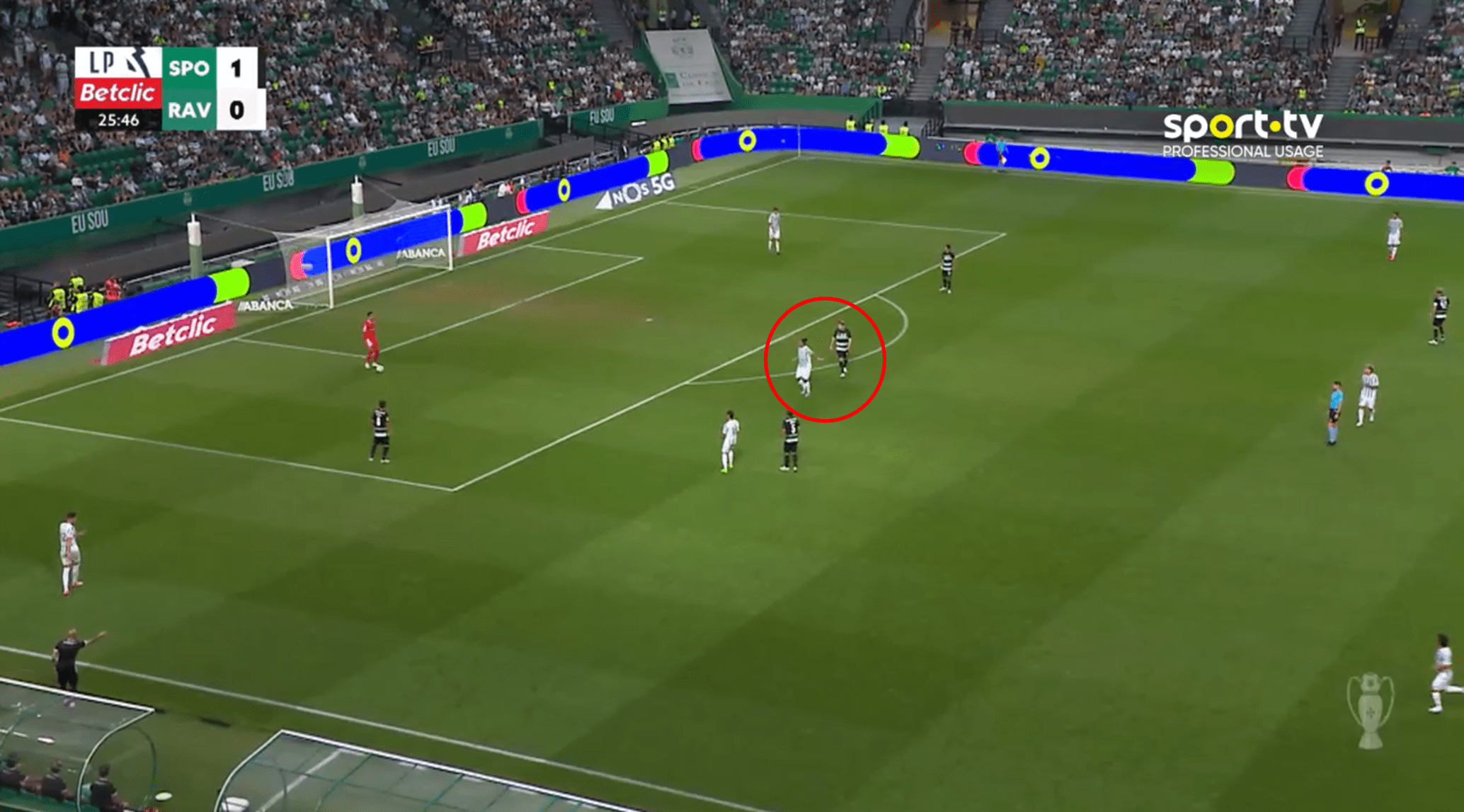
However, given Sporting’s preferred approach, teams need to be creative and prepared to respond.
Firstly, the off-the-ball movement of the defensive midfielder is essential as this could open space centrally to exploit.
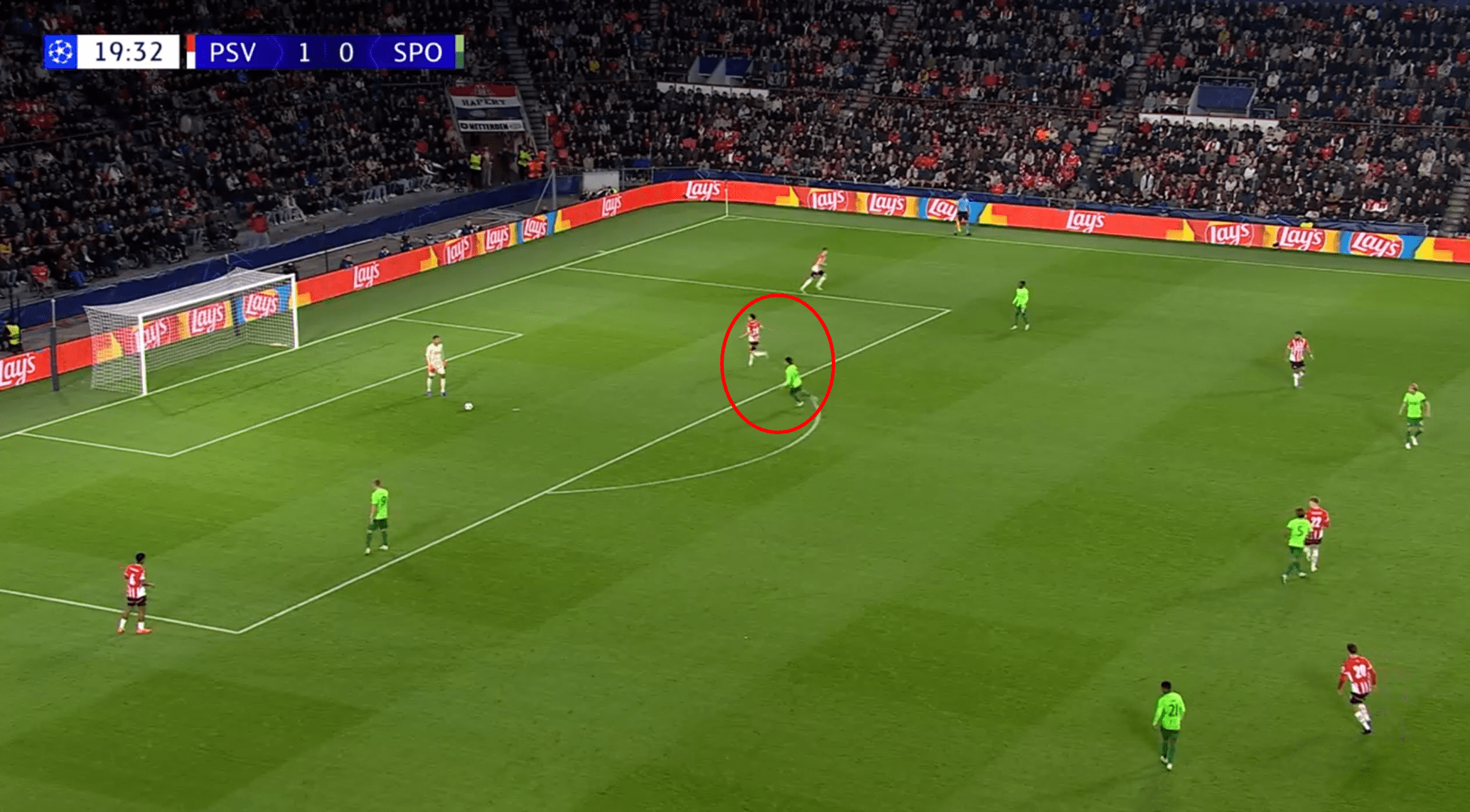
As seen above, PSV opted for this approach; however, in this instance, the goalkeeper launched the ball.
If another midfielder had dropped deeper into the space, he would have been free to receive a pass because the forward followed the defensive midfielder’s run.
Secondly, teams should set up prepared to play out from the wing.
For example, the full-backs should be positioned at an angle ready to receive possession and distribute it quickly.
The passing options should either be directed down the channel, ready for one of the front two to latch onto or a switch of play by leaving an attacking player high up, ready to accelerate towards the high defensive line.
It is recognised that this would require pace and passing precision.
However, if a team is well-drilled with such a strategy, it could be possible to break that Sporting defensive line.
Conclusion
Under Ruben Amorim tactics, Sporting has once again become a leading force in Portugal’s top flight and is making its presence known on the European stage.
A key player for the Lisbon side is undoubtedly Gyökeres, particularly his movement to the left inside channel.
However, this analysis has offered strategies for teams to disrupt the dominant nature of Sporting’s play.
A hybrid 5-4-1/4-4-2 formation could be the solution to creating a balance of an effective and measured press with a conservative approach in defence phases.
While it is recognised that tactics such as counterattacks may depend on the available playing personnel, there are certainly ways that Sporting’s tendency to control matches could be challenged.

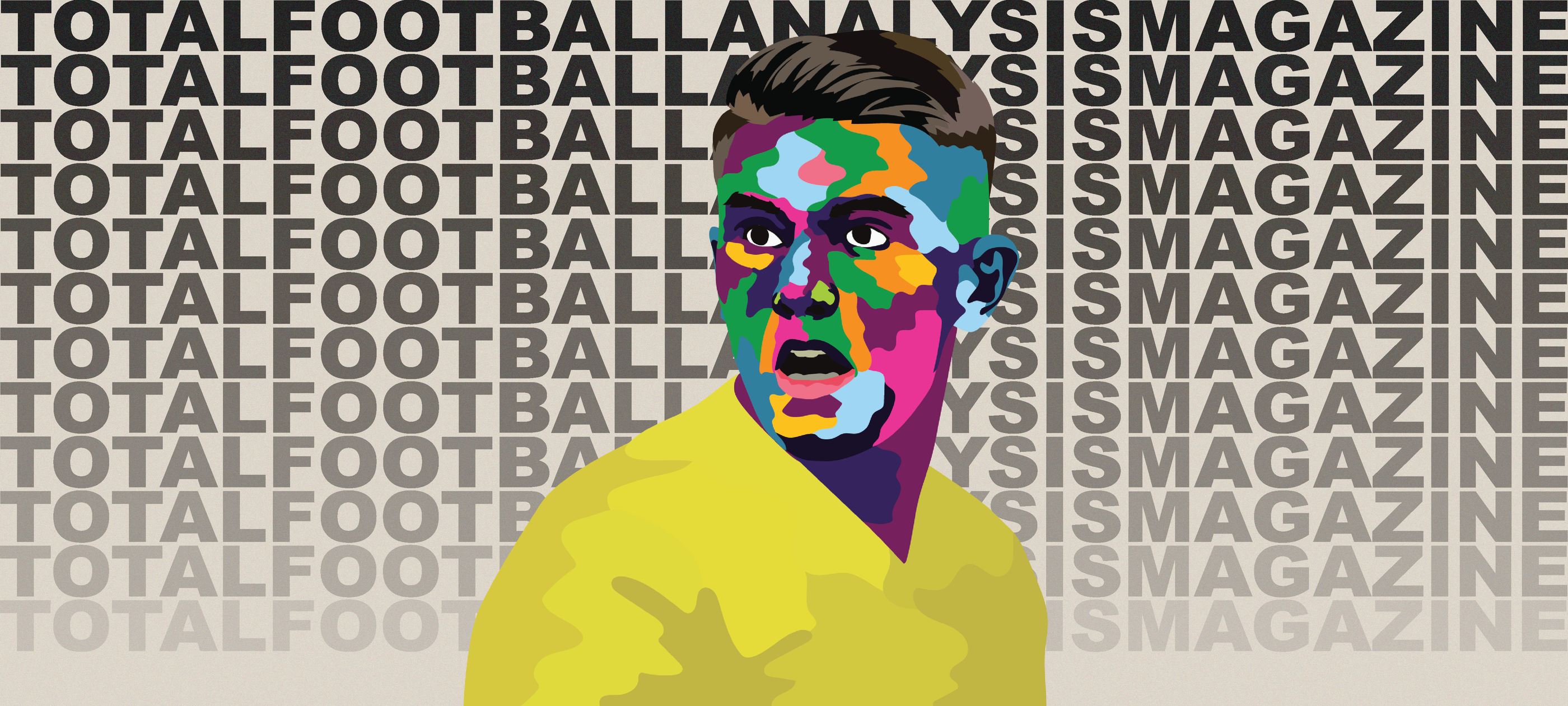




Comments